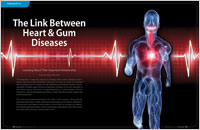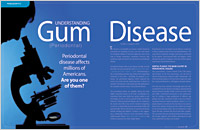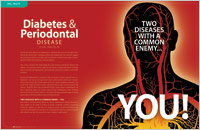Learn about soft tissue treatment for gum recession. Enhance your smile while reducing tooth sensitivity with an AlloDerm Allograft.
Gum Recession: Healthy gum tissue protects your teeth from periodontal disease and sesitivity while giving you a great smile. Routine check - ups, good homecare along with proper brushing and flossing techniques are essential to maintain healthy gums. Gum recession is sometimes treated by retrieving soft tissue from the roof (palate) of your mouth. However, removing a section of your palate creates unnecessary pain and discomfort. Now there is a better option for those of us who require treatment.
Causes and Effects: Aggressive tooth brushing and periodontal disease are two primary causes for recession which can lead to: an unattractive smile, root sensitivity, loss of supporting bone, tooth decay, plaque build-up and risk of future recession.
~~~Gum Recession leads to complications beyond esthetics~~~
About Alloderm Regenerative Tissue Matrix (RTM): Alloderm RTM provides you with an option. This is an excellent alternative to using your own tissue (retrieved from your palate). This option (AlloDerm) allows your clinician to restore your smile while providing a natural esthetic outcome.
AlloDerm Safety: Donor tissue is extensively screened and then undergoes proprietary processing to ensure that AlloDerm RTM is ready for use in patients.
AlloDerm RTM is donated tissue that has been processed to remove cells creating a Regenerative Tissue Matrix. It's success in soft tissue treatments is documented by more than 10 years of dental applications and research. Alloderm RTM is widely used in the medical and dental fields for plastic and reconstructive surgery. Since it's introduction in 1994, over one million AlloDerm RTM grafts have been successfully placed in various applications.
What to Expect: Recovery instructions can vary for each patient and will be provided by your dental specialist. The site may be covered with a dressing material. Instructions may include but are not limited to: limited tooth brushing near the site, avoid chewing near site, taking medications as prescribed. (antibiotics, pain medicines, and mouth rinses).
Are you a candidate: Discuss your full medical history with your dental specialist. Only a trained clinician can determine the best treatment plan. Please ask Dr. Schonfield to explain the benefits and risks to see if AlloDerm is right for you and always remember that patient results may vary.
Related Periodontal (Gum) Disease Articles
 The Link Between Heart & Gum Diseases
The Link Between Heart & Gum Diseases
Inflammation has emerged as a factor that is involved in the process of Cardiovascular Disease (CVD), which commonly results in heart attacks and strokes. While the precise role inflammation plays in causing chronic CVD remains an area of intense current investigation, much more is now known. The good news is that, based on current research, we know that if we can reduce the inflammation caused by periodontal disease, we can reduce the risk for heart attacks and strokes... Read Article
 Understanding Gum (Periodontal) Disease
Understanding Gum (Periodontal) Disease
Have your gums ever bled when you brushed or flossed? This most commonly overlooked simple sign may be the start of silent (periodontal) disease leading to tooth loss. Learn what you can do to prevent this problem and keep your teeth for life... Read Article
 Diabetes & Periodontal Disease
Diabetes & Periodontal Disease
Diabetes and periodontal disease are chronic inflammatory diseases that impact the health of millions of people. What you may not know is that diabetes and periodontal disease can adversely affect each other... Read Article
 Warning Signs of Periodontal (Gum) Disease
Warning Signs of Periodontal (Gum) Disease
This article provides the warning signs of periodontal (gum) disease. Don't wait until it's too late... Read Article